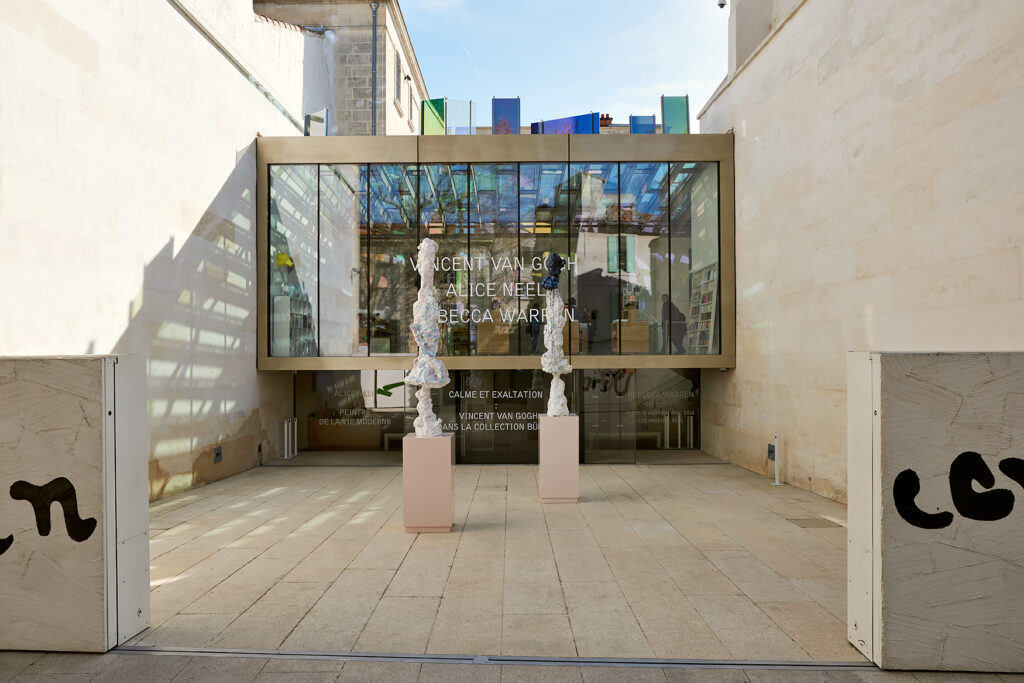
There Is Another Way, 2011, hand-painted bronze. Courtesy : The artist and Maureen Paley, London; and Los Angeles, 2013, hand-painted bronze. Courtesy : The artist and Galerie Max Hetzler, Berlin | Paris © François Deladerrière
Rebecca Warren is a sculptor of more or less figurative, more or less expressive forms in clay, bronze and welded steel, and an orchestrator of fragments displayed often but not exclusively within wall-mounted vitrines. She works with an eye to extremes – monstrous excess, alarming paucity – creating a variety of objects that she describes as existing “somewhere on the continuum between pure fleshiness and pure cartoonishness”. Hers is a restless, sometimes contradictory art, the result of sustained contemplation of the creative impulse and the mysterious potency of images and objects.
The way in which Warren’s sculpture resonates with us owes a great deal to her heightened appreciation of framing, placement and context, how her works act and react in combination with each other or within a specific setting. Expectations – principally the assumption that meaning can be distilled from appearance – are skewered. Privileged are the more complex pleasures and peculiarities of looking.
“This experimental, slapstick collision of Giacometti and Disney, literally cast or pressed into one physical body, leaves neither unharmed. In fact Warren’s sculpture could be read as a response to culturally entrenched gender tropes – the slender modernist outline on one hand, and the Disneyish codification of cuteness and effervescence on the other hand – colliding in the real world, in real people’s lives. Warren does not merely make illustrative comments by pitting two things against each other, however. There is more at play. Sticking two things together that ‘don’t fit’ is just one possible method. Another is to duplicate (while twisting the logic of duplication); another, to alter proportion (elongate, squeeze etc.). And yet another is to use materials and conventions in unconventional ways.”1
Exhibition curator: Bice Curiger
About the artist
Rebecca Warren was born in 1965 in London, where she lives and works today. Her investigation of what constitutes sculpture – the process by which the material is shaped, the irrevocable reference to tradition, the chaos of production and ambiguous interpretations – has always favoured the tactile approach to production through which sculpture is learned, above all through the mediation of touch. Rejecting the concept of sculpture as an image that seeks to enter into a pleasing collusion with its surroundings and the viewer, Rebecca Warren works in such a way that her surfaces are never wholly alluring. Equally, a number of her sculptures with a misleadingly crude appearance are created from unfired clay (e.g. Helmut Crumb, 1998; Private Schmidt, 2004). In recent years Rebecca Warren has relinquished clay in favour of bronze. The pairing of semi-abstract figurines, as in her installation at the Fondation, is part of her sculptural grammar and can also be seen, for example, in Come, Helga (2006).
Previous exhibitions (a selection):
• Rubens and His Legacy, Royal Academy of Arts, London, 2015
• The Human Factor: Uses of the Figure in Contemporary Sculpture, Hayward Gallery, London, 2014
• Riotous Baroque. From Cattelan to Zurbarán – Tributes to Precarious Vitality, Guggenheim Museum Bilbao, 2013
1 Jörg Heiser, Bronze Heads and Hair Bows in Rebecca Warren, Galerie Max Hetzler, Holzwarth Publications, 2012.



